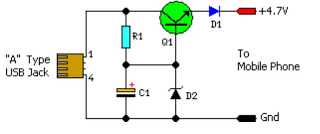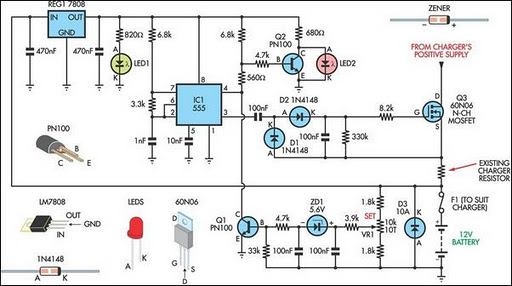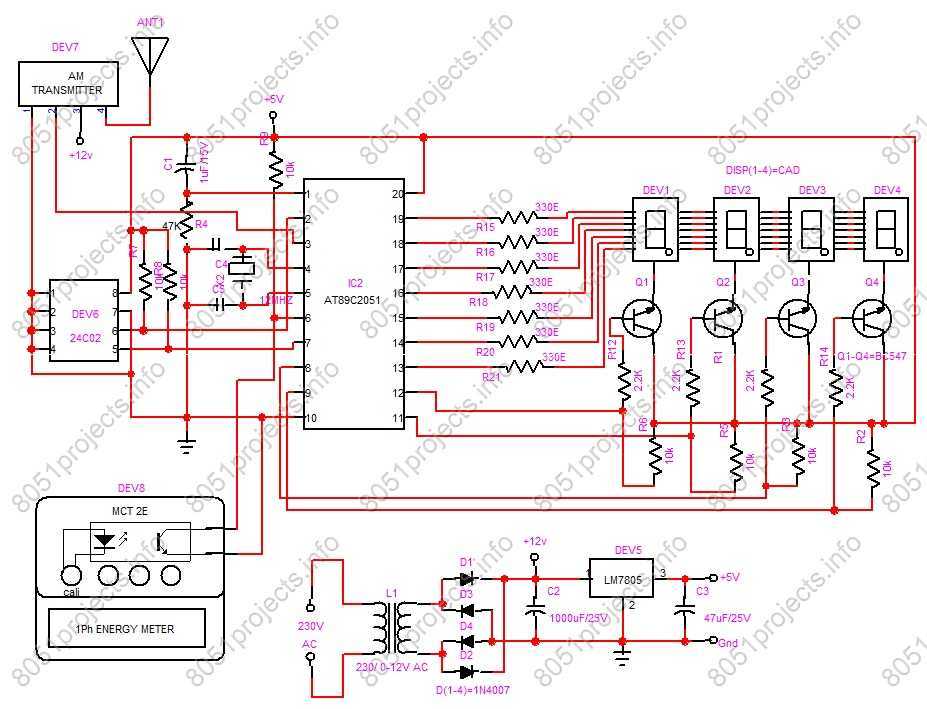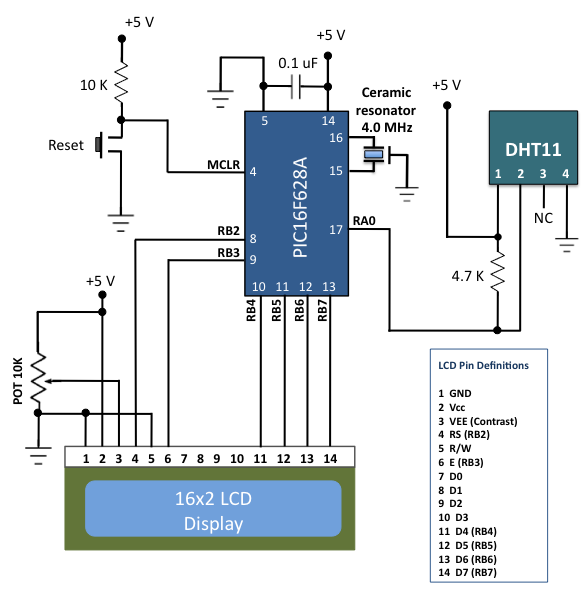
Battery Meter for Pinball Machines
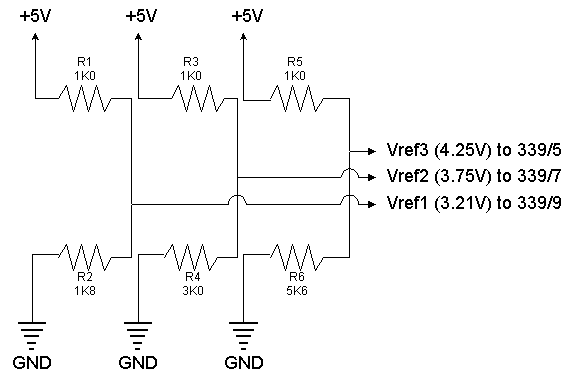
The circuit is designed to be installed in a small enclosure, which can be positioned according to preference. It requires only three connections: one for the positive terminal of the battery, one for the +5 volts supplied by the MPU board or power supply, and a common ground return. The circuit operates on 4.5-volt battery packs (three cells at 1.5 volts each). It provides battery level indication using three LEDs: one green (indicating good power), one amber/yellow (indicating mid-level), and one flashing red (indicating low battery power at approximately 3.2 volts or less). A voltage drop of 1.3 to 1.5 volts is considered sufficient for warning purposes. The circuit employs three comparators to compare the incoming battery voltage against three reference voltages established by potential dividers. These comparators drive the LEDs by sinking current to ground. Upon power-up, the green LED illuminates to indicate good battery power. As the battery voltage decreases, the amber LED lights up, followed by the flashing red LED, with all previous LEDs remaining lit until the red LED is activated. The circuit is designed to minimize component count for ease of assembly. For modifications to extinguish LEDs sequentially, a 74HC03 quad NAND gate can be utilized to sink the LED current, controlled by the sequence of the comparators. It is crucial to note that if the battery pack provides 4.21 volts or more initially, all LEDs will remain off. New batteries may not always deliver their specified voltage, and a slight voltage drop is common. The potential dividers (R1+R2, R3+R4, and R5+R6) set the reference voltages. Modifications to the output references can be calculated using the potential divider formula. The circuit is intended to fit onto a 2"x2" board. Initially, build the potential dividers and supply them with +5 volts and ground (including capacitors C1 and C2), then measure the output voltages to ensure they approximate the specified values. Next, install a 14-pin socket on the board, connecting the reference voltages to the designated pins according to the schematic, along with +5 volts and ground. Measure the voltages at the socket to confirm they are present. Subsequently, add the 330-ohm current limiting resistors (R10-R12) and the LEDs to the board, or mount them on small flyleads for installation on the enclosure cover. Finally, integrate the LM or CA339 quad comparator and power up the circuit. The green LED should illuminate (except when the battery exceeds 4.21 volts). Adjust the 10k potentiometer to verify that the LEDs light up in sequence: green, amber, and then flashing red. If the circuit fails to operate correctly, power down and check all connections. Once verified, remove the Vbat simulation and attach the three flyleads for connection to the MPU board. It is recommended to use a red wire for +5 volts, a black wire for ground, and a wire of choice for the Vbat line. Place all components in a small enclosure and mount it onto the backbox wall. Consider drilling holes in the cover for the LEDs to protrude, or use flyleads to connect them to the board and secure them in the cover. Solder the flyleads to the MPU board with the power off, allowing the board two minutes to discharge any residual charge in the onboard capacitors before soldering. It is advisable to avoid sourcing +5 volts from a chip leg; instead, find a free pad on the board for connection. Connect the battery power from the pack where it enters the board, ensuring a suitable earth point is used for the return. Maintain a neat assembly and take pride in the workmanship, ensuring that the flyleads are organized.The circuit is designed to be fitted into a small box and then fitted into your backbox (the exact choice of position is yours). Only 3 wires are required - one for the battery +v, one for the supply +5 volts from the MPU board or power supply and a common return to ground.
The circuit is designed for 4. 5 volt battery packs (3 cell x 1. 5 volts). T he circuit gives level indication using 3 LED`s - one green (good), one amber/yellow (mid) and one flashing red LED indicating low battery power - 3. 2v or less approx. I think a 1. 3-1. 5 volt drop should be enough warning - I can`t guage the drop-out voltage for CMOS memory standby in WPC games because of the ASIC, so, I`ve gone for what you see here.
3 comparators compare the incomming battery voltage against 3 reference voltages provided by 3 potential dividers (see schematic), the 3 comparators directly drive the LED`s by sinking current to ground (internal). On power-up, the Green LED will always be on indicating good battery power. As the battery voltage drops, the amber LED will light, followed by the red flashing LED, the previous LED`s remain on until all the LED`s are lit.
I designed the circuit in this manner to cut down the component count and make the building easier. If you wish to modify the circuit so that LED`s will extinguish one after the other - I suggest you use a 74HC03 quad NAND gate with open-drain outputs to sink the LED current, and, who`s input`s is switched by next comparator in sequence thereby turning the previous gate off (I would have given the schematic details here but I don`t have the IC handy to incorporate into the design at the time). IMPORTANT NOTE: If your battery pack provides 4. 21 volts or greater when new then all the leds will remain off. In most cases, new batteries do not always put out their specified voltage - a small voltage drop is usual.
The potential divers - R1+R2, R3+R4 and R5+R6 provide the reference voltages. If you wish to modify the circuit to output different references, then the potential divider voltage can be given by the formula: The circuit should fit on a board 2"x 2". Build the potential divders/voltage references first, supply them with +5 volts and ground (don`t forget capacitors C1/2) and measure the output - they should be approx the figures given.
Next:- add a 14 pin socket (absolutely vital) to the board and run the reference voltages to the correct pins according to the schematic, then +5 volts and ground - now measure the voltages at the socket to ensure they`re present. Next:- add the 330 ohm LED current limiting resistors R10-R12 followed by the LED`s to the board (or mount them on small flyleads for fitting to the box cover).
Last but not least - add the LM or CA339 quad comparator and power up. You should have the green LED on (exception, battery >4. 21v) - now rotate the 10k pot and the LED`s should light in sequence - green, amber then flashing red. If they do not then power down and CHECK YOUR CONNECTIONS. If the circuit works correctly then removed the Vbat sim. and add the 3 flyleads to allow connection to the MPU board of your game. I suggest you use a red wire for +5 volts, a black wire for ground and another wire of you choice for the Vbat line.
Add all the bits into a little box and mount the box onto the backbox wall. I suggest that you actually drill holes in the cover for the LED`s to protrude through, or, connect them to the board with small flyleads and glue them into the box cover. Solder the flyleads to the MPU board with the POWER OFF. Allow the board 2 minutes before soldering in the leads as the onboard capacitors may still hold a charge.
USE COMMON SENSE! - don`t tap the +5 volts for the circuit from a chip leg - find a free pad on the board that you can tap from. Wire the battery power from the pack were it enters the board and return to a suitable earth point. KEEP IT NEAT! - Take pride in you work - make the flyleads t 🔗 External reference
The circuit is designed for 4. 5 volt battery packs (3 cell x 1. 5 volts). T he circuit gives level indication using 3 LED`s - one green (good), one amber/yellow (mid) and one flashing red LED indicating low battery power - 3. 2v or less approx. I think a 1. 3-1. 5 volt drop should be enough warning - I can`t guage the drop-out voltage for CMOS memory standby in WPC games because of the ASIC, so, I`ve gone for what you see here.
3 comparators compare the incomming battery voltage against 3 reference voltages provided by 3 potential dividers (see schematic), the 3 comparators directly drive the LED`s by sinking current to ground (internal). On power-up, the Green LED will always be on indicating good battery power. As the battery voltage drops, the amber LED will light, followed by the red flashing LED, the previous LED`s remain on until all the LED`s are lit.
I designed the circuit in this manner to cut down the component count and make the building easier. If you wish to modify the circuit so that LED`s will extinguish one after the other - I suggest you use a 74HC03 quad NAND gate with open-drain outputs to sink the LED current, and, who`s input`s is switched by next comparator in sequence thereby turning the previous gate off (I would have given the schematic details here but I don`t have the IC handy to incorporate into the design at the time). IMPORTANT NOTE: If your battery pack provides 4. 21 volts or greater when new then all the leds will remain off. In most cases, new batteries do not always put out their specified voltage - a small voltage drop is usual.
The potential divers - R1+R2, R3+R4 and R5+R6 provide the reference voltages. If you wish to modify the circuit to output different references, then the potential divider voltage can be given by the formula: The circuit should fit on a board 2"x 2". Build the potential divders/voltage references first, supply them with +5 volts and ground (don`t forget capacitors C1/2) and measure the output - they should be approx the figures given.
Next:- add a 14 pin socket (absolutely vital) to the board and run the reference voltages to the correct pins according to the schematic, then +5 volts and ground - now measure the voltages at the socket to ensure they`re present. Next:- add the 330 ohm LED current limiting resistors R10-R12 followed by the LED`s to the board (or mount them on small flyleads for fitting to the box cover).
Last but not least - add the LM or CA339 quad comparator and power up. You should have the green LED on (exception, battery >4. 21v) - now rotate the 10k pot and the LED`s should light in sequence - green, amber then flashing red. If they do not then power down and CHECK YOUR CONNECTIONS. If the circuit works correctly then removed the Vbat sim. and add the 3 flyleads to allow connection to the MPU board of your game. I suggest you use a red wire for +5 volts, a black wire for ground and another wire of you choice for the Vbat line.
Add all the bits into a little box and mount the box onto the backbox wall. I suggest that you actually drill holes in the cover for the LED`s to protrude through, or, connect them to the board with small flyleads and glue them into the box cover. Solder the flyleads to the MPU board with the POWER OFF. Allow the board 2 minutes before soldering in the leads as the onboard capacitors may still hold a charge.
USE COMMON SENSE! - don`t tap the +5 volts for the circuit from a chip leg - find a free pad on the board that you can tap from. Wire the battery power from the pack were it enters the board and return to a suitable earth point. KEEP IT NEAT! - Take pride in you work - make the flyleads t 🔗 External reference
